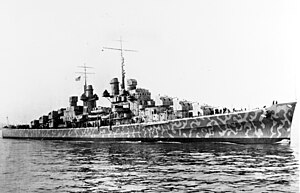USS Juneau (CL-52)

USS Juneau (CL-52), in New York harbor, 11 February 1942.
|
|
| History | |
|---|---|
|
|
|
| Name: | Juneau |
| Namesake: | City of Juneau, Alaska |
| Builder: | Federal Shipbuilding and Drydock Company, Kearny, New Jersey |
| Laid down: | 27 May 1940 |
| Launched: | 25 October 1941 |
| Sponsored by: | Mrs. Harry I. Lucas |
| Commissioned: | 14 February 1942 |
| Identification: | Hull symbol:CL-52 |
| Honors and awards: |
|
| Fate: | Torpedoed and sunk by Japanese submarine I-26 during Naval Battle of Guadalcanal on 13 November 1942 |
| Notes: | Approximate location of sinking: 10°34′S 161°04′E / 10.567°S 161.067°ECoordinates: 10°34′S 161°04′E / 10.567°S 161.067°E |
| General characteristics (as built) | |
| Class and type: | Atlanta-class cruiser |
| Displacement: |
|
| Length: | 541 ft 6 in (165.05 m) oa |
| Beam: | 53 ft (16 m) |
| Draft: |
|
| Installed power: |
|
| Propulsion: |
|
| Speed: | 32.5 kn (37.4 mph; 60.2 km/h) |
| Complement: | 673 officers and men |
| Armament: |
|
| Armor: |
|
The first USS Juneau (CL-52) was a United States Navy Atlanta-class light cruiser sunk at the Naval Battle of Guadalcanal 13 November 1942. In total 687 men, including the five Sullivan brothers, were killed in action as a result of its sinking. She was laid down by Federal Shipbuilding Company, Kearny, New Jersey, on 27 May 1940, launched on 25 October 1941, sponsored by Mrs. Harry I. Lucas, wife of the mayor of the city of Juneau, Alaska, and commissioned on 14 February 1942, Captain Lyman K. Swenson in command.
Following a hurried shakedown cruise along the Atlantic coast in the spring of 1942, Juneau assumed blockade patrol in early May off Martinique and Guadeloupe Islands to prevent the escape of Vichy French Naval units. She returned to New York to complete alterations and operated in the North Atlantic and Caribbean from 1 June to 12 August on patrol and escort duties. The cruiser departed for the Pacific Theater on 22 August.
After stopping briefly at the Tonga Islands and New Caledonia, she rendezvoused on 10 September with Task Force 18 (TF 18) under the command of Rear Admiral Leigh Noyes, flying his flag on Wasp. The following day TF 17, which included Hornet, combined with Admiral Noyes' unit to form TF 61, whose mission was to ferry fighter aircraft to Guadalcanal. On 15 September, Wasp took three torpedo hits from the Japanese submarine I-19, and, with fires raging out of control, was sunk at 2100 by Lansdowne. Juneau and screen destroyers rescued 1,910 survivors of Wasp and returned them to Espiritu Santo, New Hebrides on 16 September. The next day, the fast cruiser rejoined TF 17. Operating with the Hornet group, she supported three actions that repulsed enemy thrusts at Guadalcanal: the Buin-Faisi-Tonolai Raid; the Battle of the Santa Cruz Islands; and the Naval Battle of Guadalcanal (Third Savo).
...
Wikipedia
